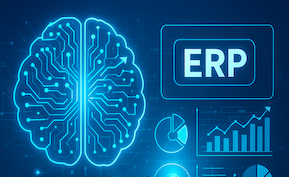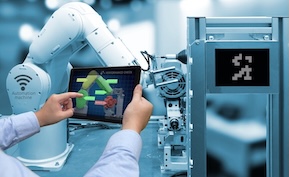Introduction: Manufacturing is undergoing a paradigm shift. Instead of the traditional “take-make-dispose” model, companies are increasingly embracing the circular economy, which emphasizes recycling, reuse, and resource efficiency. In this new framework, manufacturers are expected to design products for durability, manage returns and refurbishments, and keep materials in circulation for as long as possible. ERP (Enterprise Resource Planning) systems are stepping up to manage the complexities of circular manufacturing, particularly in areas like reverse logistics, material recovery, and lifecycle management.
What is Circular Manufacturing?
Circular manufacturing focuses on reducing waste and maximizing value from products and resources. This involves:
- Design for Reuse: Creating products that can be repaired, refurbished, or disassembled.
- Reverse Logistics: Establishing systems to handle returns, recycling, and refurbishment.
- Resource Recovery: Extracting valuable materials from products at the end of their lifecycle.
- Lifecycle Tracking: Monitoring a product’s journey from production to reuse or recycling.
Managing these loops requires significant coordination across suppliers, manufacturers, customers, and recycling partners—a task well-suited for ERP platforms.
The Role of ERP in Circular Manufacturing
ERP systems traditionally serve as the backbone of operations, linking finance, supply chain, production, and logistics. In the context of circular manufacturing, ERP expands its role to:
- Reverse Logistics Management: ERP tracks incoming returns, evaluates their condition, and assigns them for repair, resale, or recycling.
- Material Flow Transparency: ERP provides real-time visibility into materials being reintroduced into the supply chain.
- Product Lifecycle Data: By linking IoT and product serial numbers, ERP captures information on product usage, maintenance, and return cycles.
- Supplier Collaboration: ERP integrates with suppliers to source recycled inputs and certify sustainable materials.
With ERP as the central hub, manufacturers can manage complex circular workflows without losing efficiency.
Reverse Logistics: The Core Challenge
One of the most significant hurdles in circular manufacturing is reverse logistics. Unlike forward logistics, which is standardized and predictable, reverse flows are irregular and harder to control. ERP helps by:
- Return Authorization: Standardizing return approvals and linking them to customer accounts.
- Automated Routing: Directing returned items to repair centers, recycling facilities, or secondary markets.
- Condition Assessment: Integrating with IoT and scanning systems to assess product wear and tear.
- Financial Reconciliation: Updating accounting systems for refunds, credits, or warranty claims.
By treating returns as structured processes rather than exceptions, ERP reduces waste and improves customer satisfaction.
ERP and Product Lifecycle Management
ERP systems are increasingly linked with Product Lifecycle Management (PLM) solutions. Together, they provide:
- Traceability: Every product can be tracked from raw materials to final disposal or reuse.
- Sustainability Reporting: ERP aggregates lifecycle data for compliance with regulations like the EU’s Circular Economy Action Plan.
- Design Feedback Loops: ERP data on product returns informs R&D on durability and recyclability improvements.
- Resource Optimization: ERP ensures that reclaimed materials are reintegrated into production schedules.
This closes the loop between design, production, and recycling—creating a true circular economy ecosystem.
Benefits of ERP-Driven Circular Manufacturing
Manufacturers adopting ERP for circular practices can expect multiple benefits:
- Cost Reduction: Recycling and reusing materials reduces raw material expenses.
- Regulatory Compliance: Automated tracking helps meet sustainability mandates.
- Customer Loyalty: Eco-conscious consumers favor brands that practice circularity.
- Revenue Streams: Refurbished and recycled products can open new markets.
- Risk Reduction: By reducing dependence on raw materials, companies are less vulnerable to supply chain disruptions.
Implementation Challenges
Transitioning to ERP-enabled circular manufacturing comes with hurdles:
- Complex Returns: Reverse logistics requires investment in collection and inspection systems.
- Data Integration: ERP must integrate with IoT, PLM, and supply chain software for seamless tracking.
- Change Management: Employees must adapt to processes where returns and recycling are integral, not secondary.
- Initial Costs: Setting up recycling networks and refurbishing lines requires upfront investment.
However, these challenges are outweighed by the long-term benefits of cost savings and sustainability leadership.
Future of ERP in Circular Manufacturing
The role of ERP in circular manufacturing will expand as technology advances:
- AI-Driven Sorting: ERP-integrated AI will categorize returned items automatically for reuse or recycling.
- Blockchain Transparency: ERP may leverage blockchain to verify recycled content in products.
- Digital Product Passports: Regulations may require every product to carry a digital record of its lifecycle, stored in ERP systems.
- Closed-Loop Supply Chains: ERP will orchestrate truly circular systems where waste becomes input for new products.
These innovations will cement ERP’s role as the backbone of sustainable manufacturing.
Conclusion
ERP is no longer just about managing production and accounting—it is becoming the enabler of sustainability in manufacturing. By integrating reverse logistics, product lifecycle tracking, and material recovery, ERP systems make circular manufacturing not only possible but profitable. Companies that leverage ERP for circularity position themselves as industry leaders, meeting consumer expectations and regulatory demands while reducing costs. The future of manufacturing is circular, and ERP is at the heart of this transformation.







